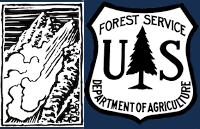Photos
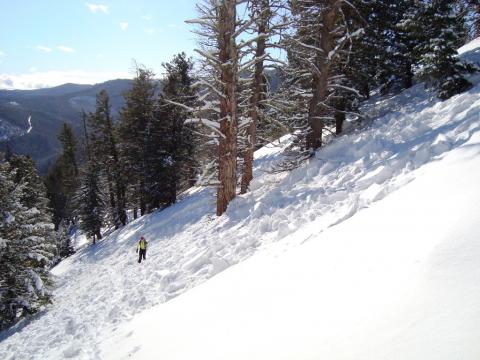
|
Southern Madison, 2011-12-31 As we skinned through the trees we came across a natural slide on a small slope, a sure sign that avalanche danger was HIGH. Photo: GNFAC |
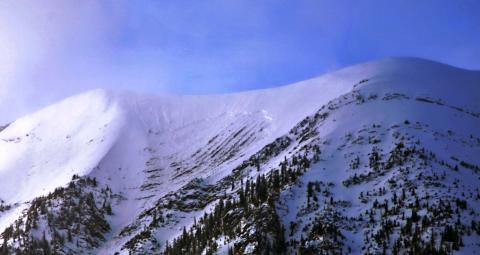
|
Bridger Range, 2011-12-31 Saddle Peak slid naturally today. Weak snow underlying the new snow ( 1+ feet) created unstable conditions. Photo: Pat Clayton |
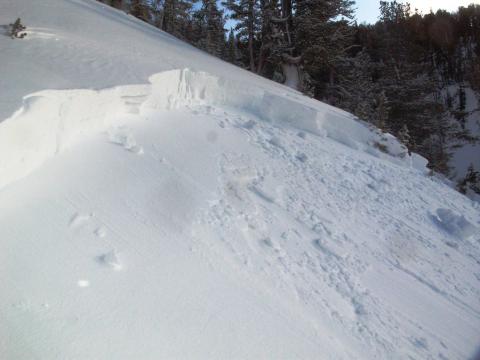
|
Cooke City, 2011-12-31 Eric Knoff triggered this path in Miller Creek outside Cooke City remotely. The new snow (3 feet) was stressing many slopes to the point of failure. Photo: GNFAC |
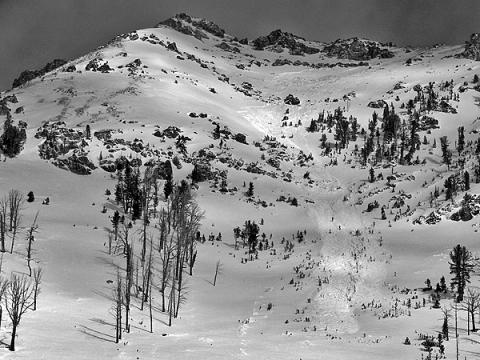
|
Cooke City, 2011-12-31 This natural avalanche in Sheep Creek outside Cooke City ran over a thousand feet. It was south facing, but a few north facing slides avalanched too. Collapsing and cracking were noted throughout the day. Photo: Beau Fredlund |
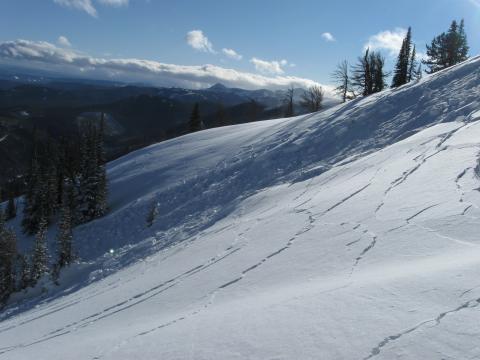
|
Lionhead Range, 2011-12-31 This slide was triggered at the same time as several others while hiking along a ridge. We were about 800 ft away from this part of the slide. Remotely triggered avalanches like this one are a sign of very unstable conditions. It broke about 1-1.5 ft deep and ran about 1000 ft vertical. Photo: GNFAC
|
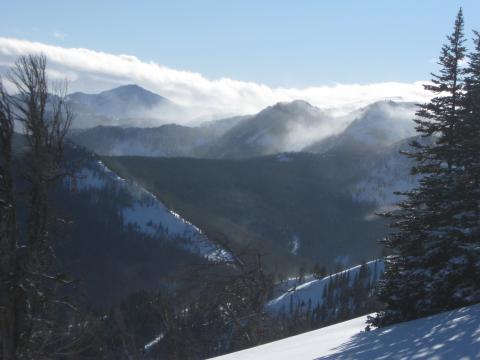
|
Lionhead Range, 2011-12-31 Strong winds transported snow today (Sat.) in the Lionhead area near West Yellowstone. This wind loading will keep many slopes unstable. Photo: GNFAC |
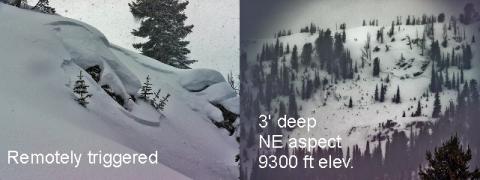
|
Cooke City, 2011-12-31 The small photo on the left was a small avalanche triggered remotely which is a prime indication of unstable conditions. The natural avalanche in the photo on the right was spotted later in the same area. In the past 72 hours, the Cooke City area has received 4inches of SWE (about 4ft of snow). Photo: B. Fredlund |
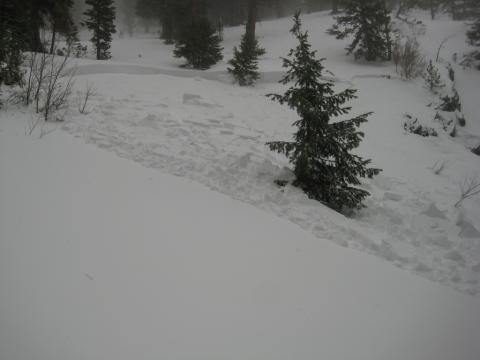
|
Southern Madison, 2011-12-30 Skiers remotely triggered this avalanche from 100 feet away in the southern Madison Range near Quake Lake. They also got cracks to shoot 50-75 feet away. New snow fell onto a very weak snowpack over our southern mountains. This slide was 12" deep, 75 feet wide and ran 100 feet downhill. They wrote, "Called it a day and headed home after that." Photo: Anon |
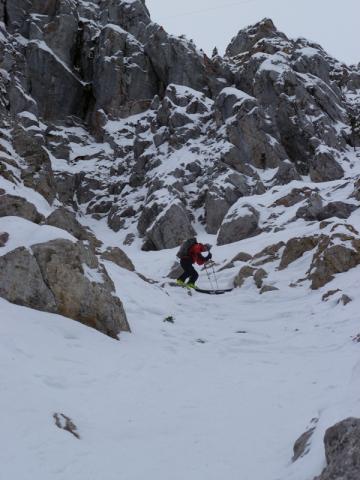
|
Bridger Range, 2011-12-24 Mark Staples picks his way through Northwest Passage at the north end of Bridger Bowl. Photo GNFAC |
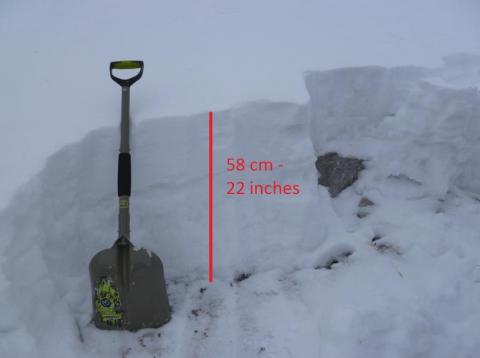
|
Bridger Range, 2011-12-24 A shallow and weak snowpack exists throughout the Bridger Range. This photo was taken near the ski area boundary just north of the Apron. Photo GNFAC |
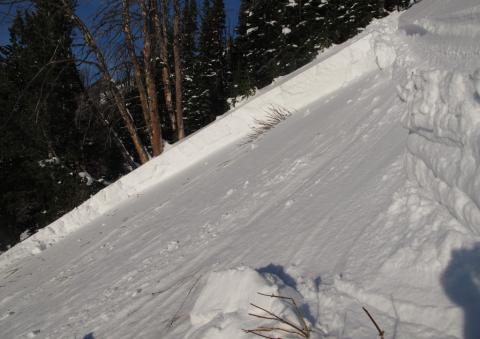
|
Northern Madison, 2011-12-23 A skier triggered this slide on a west facing slope as he dropped into Beehive Basin from the Bear/Beehive divide. The slope was 35 degrees steep and the slide broke on well developed facets two feet deep. It ran about 50 feet wide into trees. A snowpit on Dec 18 on a similar aspect and elevation showed this weakness in stability tests. The 10-12" of new snow Wednesday added enough stress to create unstable conditions on this slope. Photo: Anon |
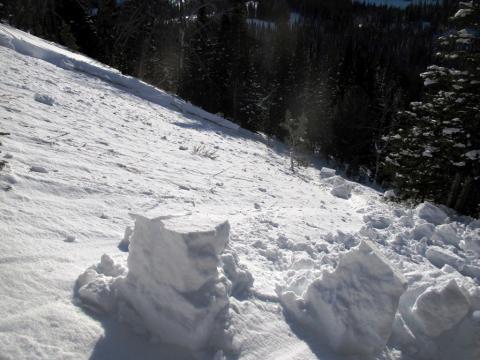
|
Northern Madison, 2011-12-23 This skier triggered avalanche broke on well-developed facets at the ground. No one was caught. Photo: Anon |

|
Northern Gallatin, 2011-12-23 Winds increased yesterday afternoon and easily transported snow to the lee sides of ridges. Windy conditions are expected through the Christmas weekend. Photo: B. VandenBos |

|
Northern Gallatin, 2011-12-22 After a Wednesday's storm this was the only natural avalanche we could find from the top of Palace Butte. it occurred on Elephant Mtn. on a southerly aspect and appears to have been cross loaded by east winds. Photo: GNFAC |

|
Southern Madison, 2011-12-22 Two layers of surface hoar (up to 2 cm flakes) are in the upper few inches of the snowpack around Lionhead. The rest of the snowpack is fist to 4-finger hardness faceted grains which are not strong. The avalanche danger will rise with more snow on these layers. Photo: GNFAC |

|
Cooke City, 2011-12-20 A small human triggered slab avalanche in Sheep Creek outside Cooke City. Approximately 4-10" deep and about 60' wide; NE facing slope around 9400'. Photo: Beau Fredlund |

|
Lionhead Range, 2011-12-18 A shallow and weak snowpack exists in the mountains outside of West Yellowstone. Without a slab there is little avalanche danger, but once we get more snow the danger will rise rapidly. This photo was taken near Two Top. Photo GNFAC |

|
Cooke City, 2011-12-18 Wind loaded slopes, specifically slopes below ridgelines will be likely places to find unstable snow. This small slide occurred near Lulu Pass outside of Cooke City. Photo GNFAC |

|
Cooke City, 2011-12-18 Natural slab avalanche near Iceberg Peak outside of Cooke City. This slide occurred on a NE facing slope and was likely the result of a heavy wind load. Photo Beau Fredlund |
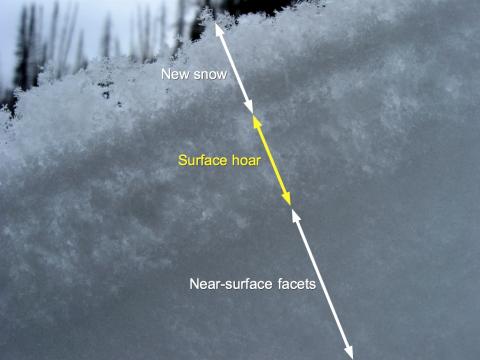
|
Southern Madison, 2011-12-14 Recently formed surface hoar (frozen dew) was capped by new snow. This means it will survive and become problematic weak layer once a slab forms on top of it. Surface hoar is often destroyed before it is buried. Unfortunately, it doesn't really matter b/c the snow underneath is very faceted and very weak. It will also make a great weak layer and produce avalanches. We found this situation on all slopes in the Southern Madison Range. Photo: GNFAC |
